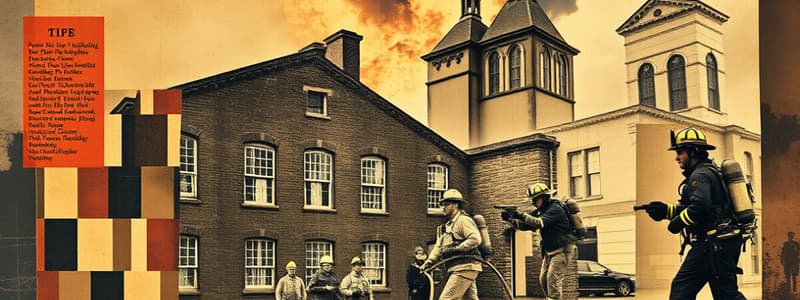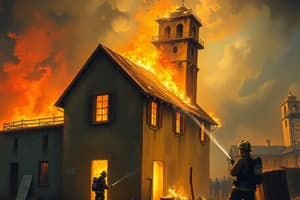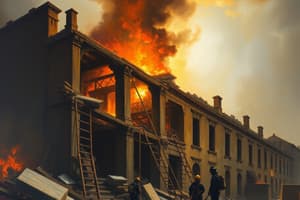Podcast
Questions and Answers
What is the primary reason for making long, narrow strips perpendicular to the corrugations when cutting insulation?
What is the primary reason for making long, narrow strips perpendicular to the corrugations when cutting insulation?
- To open as many valleys in the decking as possible (correct)
- To minimize damage to the surrounding structure
- To facilitate quicker access to the hose streams
- To increase the fire's airflow and spread
How should you initially approach creating insulation cuts in the decking?
How should you initially approach creating insulation cuts in the decking?
- By pulling up a large section at once to gain visibility
- By making endless small cuts without a plan
- By first pulling up a small section to assess the corrugation direction (correct)
- By cutting randomly to expedite fire containment
What strategy is implied for cutting insulation to manage fire spread effectively?
What strategy is implied for cutting insulation to manage fire spread effectively?
- Cutting in the same direction as the corrugations for efficiency
- Cutting ahead of the fire to intercept its path (correct)
- Creating a series of circular cuts to confuse the fire
- Making cuts late to limit fire exposure
Which of the following actions should be avoided when dealing with insulation cuts in corrugated decking?
Which of the following actions should be avoided when dealing with insulation cuts in corrugated decking?
What is the primary purpose of cooling the bottom of the frying pan during a fire situation?
What is the primary purpose of cooling the bottom of the frying pan during a fire situation?
Why is it important to recognize the speed of fire spread across the corrugations?
Why is it important to recognize the speed of fire spread across the corrugations?
What is the recommended action if there is not heavy fire in the contents below during firefighting?
What is the recommended action if there is not heavy fire in the contents below during firefighting?
Why is it not desirable to cut through the metal deck when making insulation cuts?
Why is it not desirable to cut through the metal deck when making insulation cuts?
Which of the following methods should be employed by firefighters on the roof during a fire response?
Which of the following methods should be employed by firefighters on the roof during a fire response?
What is a significant benefit of using 21 1/2 in. hose streams in high ceiling structures?
What is a significant benefit of using 21 1/2 in. hose streams in high ceiling structures?
In a fire response situation, which component is crucial to control flammability in a frying pan scenario?
In a fire response situation, which component is crucial to control flammability in a frying pan scenario?
Why may a fire occur in a fully sprinklered building despite the installation of sprinklers?
Why may a fire occur in a fully sprinklered building despite the installation of sprinklers?
What is an essential precaution when dealing with a metal deck roof fire?
What is an essential precaution when dealing with a metal deck roof fire?
In which type of structures is the use of large hose streams most beneficial?
In which type of structures is the use of large hose streams most beneficial?
What role does ventilation play in firefighting within metal deck structures?
What role does ventilation play in firefighting within metal deck structures?
What is the primary risk associated with lightweight construction techniques in renovated buildings?
What is the primary risk associated with lightweight construction techniques in renovated buildings?
Why is it critical for firefighters to identify renovations in buildings?
Why is it critical for firefighters to identify renovations in buildings?
How should command officers respond to the presence of renovated lightweight structures?
How should command officers respond to the presence of renovated lightweight structures?
What historical construction type is mentioned as being safe before renovation with lightweight materials?
What historical construction type is mentioned as being safe before renovation with lightweight materials?
Why did the FDNY implement a policy against cutting metal deck roofs?
Why did the FDNY implement a policy against cutting metal deck roofs?
Which action is recommended for firefighters concerning ongoing renovations?
Which action is recommended for firefighters concerning ongoing renovations?
What is the consequence of not performing roof ventilation on a burning building?
What is the consequence of not performing roof ventilation on a burning building?
What critical action should be taken before venting a metal deck roof?
What critical action should be taken before venting a metal deck roof?
What can occur when fire exposes the underside of a metal deck roof?
What can occur when fire exposes the underside of a metal deck roof?
Which of the following statements best describes the nature of the fire under a metal deck roof?
Which of the following statements best describes the nature of the fire under a metal deck roof?
What should be done to protect roof supports during firefighting operations?
What should be done to protect roof supports during firefighting operations?
What is the ultimate goal when managing a fire involving a metal deck roof?
What is the ultimate goal when managing a fire involving a metal deck roof?
What is the primary purpose of using elevating platforms during fire operations?
What is the primary purpose of using elevating platforms during fire operations?
When assessing a structure after knocking down a fire, what is the recommended approach?
When assessing a structure after knocking down a fire, what is the recommended approach?
What precaution should be taken to avoid operating under potentially unsafe trusses?
What precaution should be taken to avoid operating under potentially unsafe trusses?
Why is it important to operate with the minimum number of personnel in dangerous areas during fire operations?
Why is it important to operate with the minimum number of personnel in dangerous areas during fire operations?
What role do Computer-aided dispatching systems (CADS) play in fire operations?
What role do Computer-aided dispatching systems (CADS) play in fire operations?
When should aggressive interior operations cease during a fire in a lightweight truss roof building?
When should aggressive interior operations cease during a fire in a lightweight truss roof building?
What should a firefighter assess to determine if offensive operations are justified?
What should a firefighter assess to determine if offensive operations are justified?
What is the primary guideline regarding firefighter safety when there are potential civilian life hazards?
What is the primary guideline regarding firefighter safety when there are potential civilian life hazards?
Under what conditions should a firefighter avoid risking their lives during firefighting operations?
Under what conditions should a firefighter avoid risking their lives during firefighting operations?
What tactical method should be utilized when approaching a fire in a structure where interior operations pose significant risks?
What tactical method should be utilized when approaching a fire in a structure where interior operations pose significant risks?
Why should firefighters avoid lingering in a building during a firefighting operation?
Why should firefighters avoid lingering in a building during a firefighting operation?
What approach should be taken if heavy fire is attacking the structural elements during a firefighting operation?
What approach should be taken if heavy fire is attacking the structural elements during a firefighting operation?
What is a key element in decision-making for firefighters when responding to potential life hazard situations?
What is a key element in decision-making for firefighters when responding to potential life hazard situations?
Start __ stores over from the fire store in a row of attached stores
Start __ stores over from the fire store in a row of attached stores
Opening up the buildings _____ and directing a stream into the truss loft may be quite useful
Opening up the buildings _____ and directing a stream into the truss loft may be quite useful
You may have to provide emergency ____ when examine under lightweight buildings
You may have to provide emergency ____ when examine under lightweight buildings
Flashcards
Metal deck roof collapse risk
Metal deck roof collapse risk
Bar joist-supported metal deck roofs are prone to early collapse, making operations dangerous.
FDNY metal roof policy
FDNY metal roof policy
FDNY prohibits cutting metal decks and roof ventilation efforts.
Roof ventilation importance
Roof ventilation importance
Ventilation is crucial; otherwise, interior forces can drive out of the building easily, leading to building collapse.
Safe metal roof operations
Safe metal roof operations
Signup and view all the flashcards
Cooling exposed steel joists
Cooling exposed steel joists
Signup and view all the flashcards
Direct roof cutting hazard
Direct roof cutting hazard
Signup and view all the flashcards
Rapid metal deck fire spread
Rapid metal deck fire spread
Signup and view all the flashcards
Cooling roof underside
Cooling roof underside
Signup and view all the flashcards
Minimizing roof damage
Minimizing roof damage
Signup and view all the flashcards
Long narrow cuts method
Long narrow cuts method
Signup and view all the flashcards
Large hose streams effectiveness
Large hose streams effectiveness
Signup and view all the flashcards
Ventilation for firefighter safety
Ventilation for firefighter safety
Signup and view all the flashcards
Renovated building hazards
Renovated building hazards
Signup and view all the flashcards
Documenting lightweight construction
Documenting lightweight construction
Signup and view all the flashcards
Renovation operation policies
Renovation operation policies
Signup and view all the flashcards
Roof collapse and interior operations
Roof collapse and interior operations
Signup and view all the flashcards
Risk vs. civilian life
Risk vs. civilian life
Signup and view all the flashcards
Offensive operations justification
Offensive operations justification
Signup and view all the flashcards
Post-fire structural assessment
Post-fire structural assessment
Signup and view all the flashcards
Window ventilation and lighting
Window ventilation and lighting
Signup and view all the flashcards
Gradual examination openings
Gradual examination openings
Signup and view all the flashcards
Emergency shoring
Emergency shoring
Signup and view all the flashcards
CAD system use
CAD system use
Signup and view all the flashcards
Study Notes
Operations on Metal Deck Roofs
- Firefighters are advised against operating on bar joist-supported metal deck roofs due to early collapse risks.
- FDNY official policy since Spring 2001 prohibits cutting metal deck roofs, halting roof ventilation efforts.
- Without ventilation, interior forces may be driven out, leading to potential building surrender, especially if over 50% is heavily involved.
- Safe operations on metal roofs are possible through assessed fire involvement and coordinated fire attacks.
- It’s crucial to cool exposed steel joists to prevent failure by using hoselines, starting attacks in areas adjacent to the fire.
- Cutting roofs directly over the fire is dangerous; proper assessment and ventilation must be prioritized.
- Metal deck fires can occur without direct exposure below, leading to rapid fire spread via heated tar and flammable gases above the insulation.
- Firefighters must cool the underside of the roof to stop gas production and control the fire effectively.
Strategies for Addressing Metal Deck Fires
- Minimize roof damage by making small insulation cuts (2x2 ft) to gauge the direction of corrugations first.
- Create long, narrow cuts perpendicular to corrugations to access fire paths and stop its spread.
- Large 21 1/2 inch hose streams are effective for high-ceiling properties like warehouses where metal deck fires can occur, even in sprinklered buildings.
- Always ensure ventilation is in place to maintain a safe environment for firefighters in case of roof fires or fires in contents below.
Hazards in Renovated Buildings
- Renovated buildings often use lightweight construction techniques, which can mislead firefighters regarding structural integrity.
- Firefighters should identify and document lightweight construction during renovations, ensuring communication with all responding units.
- Command officers must create policies aimed at operations in structures that have undergone renovations, acknowledging the hidden dangers of lightweight elements.
Operational Considerations in Occupied Structures
- If roof ventilation is impossible due to collapse fears, interior operations must also be reevaluated for safety.
- Decisions about risk vs. potential civilian life saving are critical; determine if fire has breached structural voids.
- Offensive operations may be justified if the fire is contained without void penetration, but strategic withdrawal is needed if heavy fire threatens structural elements.
After Fire Control Measures
- Post-knockdown, careful structural assessments are essential; total window ventilation and lighting aid evaluations.
- Create examination openings in the truss loft gradually, using minimum personnel until the situation is deemed safe.
- Emergency shoring is critical for ensuring stability after identifying potential hazards.
- Computer-aided dispatching systems serve as valuable resources for details about building structures over time.
Studying That Suits You
Use AI to generate personalized quizzes and flashcards to suit your learning preferences.




